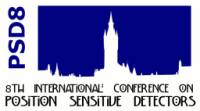Speaker
Dr
Giullio villani
(Rutherford Appleton Laboratory)
Description
An innovative circuit topology for solid-state pixel detectors based on latch up effect is described. This effect, normally considered detrimental in CMOS devices when triggered by SEU or external radiation, is exploited in solid state electronic switches (e.g. thyristor and SCRs). Here it is proposed to use this effect as part of a building block for low power, low noise, fast and much simplified particle and radiation detection. The latch up effect is based on a positive feedback triggered in a loop of active devices by an injected charge. Following latch up, the circuit retains its final state until reset and the next cycle of readout is started. A detector prototype with sensitivity of approximately 1pC based upon commercial components was built and tested confirming the working principle. A new prototype with increased charge sensitivity is currently being investigated in a commercial deep-submicron CMOS technology. A further improvement with the possibility of accurately selecting the threshold of ignition is currently being investigated. It is based on commercially available MOS transistors, routinely used as building blocks for digital memory cells (i.e. EPROM or FLASH). A prototype using commercial components is being built to validate the concept and to understand the limitations. Simulations and measurements results will be presented. This approach in principle could greatly simplify the readout of particle and radiation detectors, as most of the standard blocks, like charge amplifier, buffers or comparator, are implemented using fewer programmable devices.
Author
Dr
Giullio villani
(Rutherford Appleton Laboratory)

